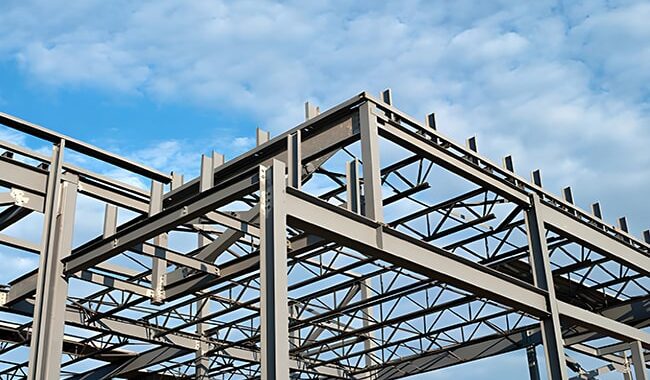A steel frame is a structure made of steel, usually connected by welding, bolting, or riveting steel beams, columns, bracing,…
“Solid steel structure, build an extraordinary future” high-quality steel structure, build a safe and durable building for you, and achieve every great dream!
What is Steel Structure
The steel structure is a building component made of steel (such as steel plates, round steel, steel pipes, steel cables, and various steel sections), including steel beams, columns, trusses, etc. These components are spliced into a whole by welding, rivets, or bolts and finally transported to the site for installation to form the required steel structure building. For example, steel structures are widely used in warehouses, factories, bridges, office buildings, shopping malls, and other building types.
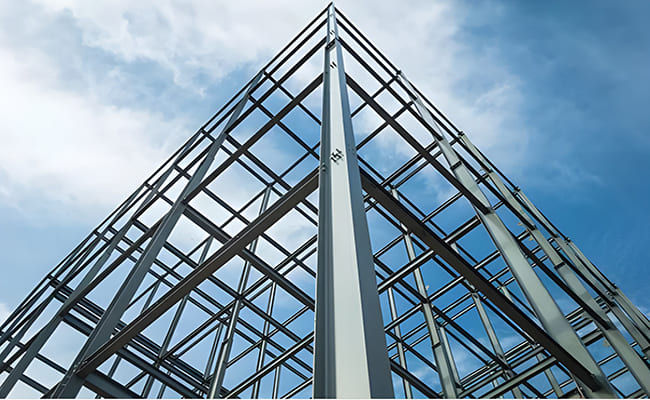
The role of steel structure in modern architecture
Steel structure buildings have become an indispensable part of modern architecture and occupy an important position in future architectural trends. The steel structure is widely used in many modern buildings due to its high strength, low deadweight, excellent seismic performance, and the possibility of a large-span spatial structure. Large buildings such as skyscrapers, gymnasiums, and high-speed rail stations often use steel structures, which can not only speed up construction but also effectively reduce construction waste, achieve the purpose of environmental protection and sustainable development, and become the representative of green buildings.
Steel Structure Benefits:
Modern buildings are designed and constructed with steel structure, which has the following significant benefits:
High space utilization efficiency:
Compared with traditional buildings, the benefit of steel structures is that they can better meet the needs of large spans and flexible layouts. Large-span steel structures are built with steel components such as beams and trusses and do not require central columns. In addition, using H-shaped steel columns can reduce the column section by more than 40%, which improves the space utilization rate of the building and effectively increases the available area. Steel structures can provide more spacious interior space than traditional structures, and the effective indoor use area is about 6%-8% higher than conventional buildings. This efficient space utilization makes steel structures ideal for warehousing, industrial plants, and large commercial buildings.
Excellent seismic and wind resistance:
The high strength and toughness are unique to steel structures (yield strength can reach more than 355MPa), which gives buildings excellent earthquake and wind resistance. According to the “Building Seismic Design Code,” steel structures can effectively withstand an earthquake intensity of 8 degrees, and their ductility coefficient is 3-5 times that of concrete structures. Through friction-type high-strength bolt connections and buckling-restrained support technology, energy can be dissipated through plastic deformation under extreme loads, significantly reducing the risk of structural damage.
Flexible and diverse design:
Steel structures can be pre-processed in factories, and the shapes can be customized, making the design more flexible. Complex shapes such as spires, domes, arcs, and unique shapes can be easily realized, so many buildings with unique aesthetic shapes mostly use steel structures.
Fast construction speed and reduced cost:
Steel structures are constructed much faster than traditional methods, and the construction period can usually be shortened by one-third, directly reducing the comprehensive cost and saving about 5% of the construction cost. In addition, shortening the construction period can also improve the efficiency of capital turnover and significantly improve the investment benefits.
Environmentally friendly and sustainable:
Steel structure buildings align with the circular economy concept, with a material recovery rate of over 90% and carbon emissions reduced by 35% compared with concrete structures. Using hot-dip galvanizing anti-corrosion and rock wool insulation systems reduces building energy consumption by 20%-30. Prefabricated construction reduces on-site construction waste by 80% and dust by 70% and has been widely recognized by international green certification systems such as LEED and WELL.
Types of Steel Structure
Portal steel structure: a solid foundation
Portal steel frame is one of the most commonly used structural systems. It has a simple structure and is mainly composed of steel beams, steel columns, supports, purlins, tie rods, gable frames and other components. Portal frames are widely used in various simple structure buildings, such as factories, warehouses, office buildings, supermarkets and various public facilities. Its advantages include simple structure, clear force transmission path, safety and durability, simple processing and short construction period. Portal steel frame has a history of nearly 100 years, and its design, production and construction standards are very mature.
Truss structure: a combination of high efficiency and strength
Truss structure is a beam-type component composed of multiple small-section rods, which is “hollow” in shape, has strong bending resistance and small deflection. Compared with solid beams, truss structure saves more materials, is lighter in weight and can achieve a larger span. Common forms of trusses include triangles, rectangles, trapezoids, arches, etc. Truss structures are often used in buildings such as large-span factories, exhibition halls and bridges, especially in the roofs of buildings. Trusses are sometimes called roof trusses, usually referring to truss beams.
Space Frames: Revolutionizing Large-Scale Design
Space frame structures are a type of spatial bar structure, where the load-bearing members are connected by nodes in a certain pattern, and are lightweight, highly rigid, and have good seismic resistance. Because of the regularity of its structural combination and the fact that a large number of members and nodes have the same shape and size, they are easy to process in the factory and install on site. Space frame structures are often used for roofs of buildings such as gymnasiums, theaters, exhibition halls, waiting rooms, and hangars. Its advantages include low spatial forces, light weight, high rigidity, and good seismic resistance.
Arch and Shell Structures: Elegant and Durable Design
Shell structures are a type of spatial structure consisting of curved plates and edge members such as beams, arches, or trusses. Shell structures have excellent spatial force transmission performance and can form load-bearing structures with high load-bearing capacity and rigidity with a small member thickness. It can cover or enclose large spans without the need for intermediate pillars, while taking on the dual functions of load-bearing and enclosure structures, thereby saving materials. The shell structure can be designed into various shapes according to engineering requirements and is widely used in large-span building roofs, small and medium-span roof panels, engineering structures, linings, industrial pipelines, pressure vessels, cooling towers, reactor containment, radio towers, liquid storage tanks and other fields.
Hybrid steel structure: Combining strength and flexibility
Steel-concrete structure comprises concrete with ordinary steel bars, steel mesh or steel skeleton, and is mainly used for load bearing. This type of structure is usually used in large public buildings, industrial buildings and high-rise residential buildings. Common steel-concrete structures include shear wall structure and frame structure, both of which are a combination of steel structure and concrete structure. Steel-concrete structure can provide both high strength and great flexibility, and is widely used in complex building designs.
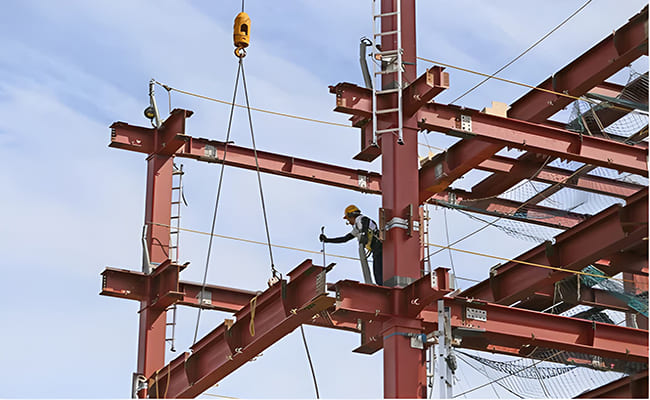
Key components of steel structure
Beam: the pillar of the steel structure frame
Beam is a component in the steel structure that mainly bears horizontal loads and is perpendicular to its central axis. For example, floor beams, wall guide beams, purlins and crane beams in light steel houses are all typical applications of beams. Steel beams usually show bending or bending and torsion deformation under external loads. As an important support for modern buildings, steel beams provide the necessary strength and support to ensure the stability and safety of buildings and bridges. Its design purpose is to bear the load and effectively transfer it to the support.
Column: Stability of vertical support
Steel columns are longitudinal components in steel structure frames, which can be divided into solid columns and lattice columns according to the cross-sectional form. Steel columns are widely used in large and medium-sized industrial plants, large-span public buildings, high-rise buildings, light mobile houses, work platforms, trestles and brackets. The main function of steel columns is to bear and support to ensure the stability and safety of the building structure.
Floor slabs and panels: the building foundation of steel frames
Floor slabs, commonly known as floor decks, are cold-pressed corrugated steel plates that can be V-shaped, U-shaped, or trapezoidal. Concrete is poured on the surface to form a composite floor slab, which is mainly used for laying mezzanine floors. The roof and wall panels of steel structure buildings usually use color steel plates or sandwich panel. These materials are economical and practical and are an important part of steel structure buildings.
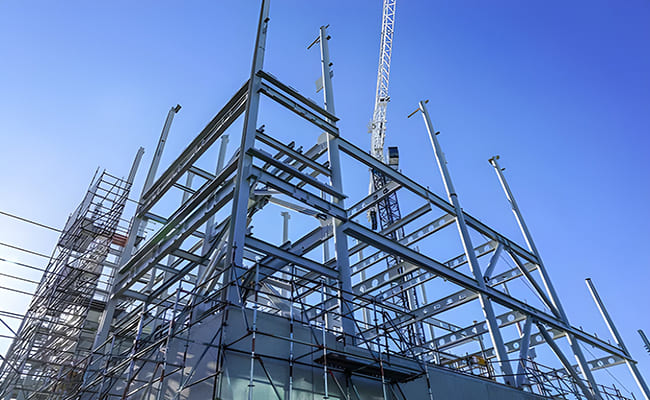
Steel structure fabrication
Steel component fabrication process: from concept to construction
The manufacturing of steel components is the process of processing steel into specific components, mainly including lofting, numbering, cutting, correction, forming, edge processing, hole making, welding, component assembly, round tube component processing and steel component pre-assembly. The quality of each link directly affects the performance and safety of the final component. The quality of steel component processing not only depends on advanced equipment, but also closely related to the technical level of workers and the management level of the factory. In each step, the timely intervention of quality inspectors is the key to ensuring processing quality.
Cutting, bending, and welding
The common cutting methods for steel cutting include shearing, punching, sawing, gas cutting, etc. The process to be selected should be determined according to actual needs and working conditions. After cutting, the steel should avoid delamination and cracks, and impurities such as flash and slag from the cut must be removed. The deviation of gas cutting and mechanical shearing needs to meet relevant standards.
In the process of steel component fabrication, welding is the most common connection method. Arc welding is the main welding technology in the field of steel structure, including arc welding, submerged arc welding and gas shielded welding, etc.; in special occasions, electroslag welding is also widely used.
Quality control in steel component fabrication
In order to ensure the quality of steel components, strict control must be carried out from the following aspects:
Accuracy of drawings: The processing drawings must be complete and clear, including detailed information such as material, model, node, hole spacing, etc. Drawing errors will lead to processing problems, so optimizing and checking drawings is the first and most important step in processing.
Raw material control: Check one by one according to the quality certificate and size specification table of steel, and check the surface quality, thickness, flatness, etc. of steel. Welding materials must match steel, and welding materials must be checked before use to ensure that they are qualified.
Steel cutting and hole making: Before cutting, the cleanliness, flatness and verticality of the steel must be checked to ensure that the material meets the processing requirements. When making holes, a precise die drilling process must be used to ensure the accuracy of the hole position and size.
Advances in steel component fabrication
With the development of science and technology, steel component fabrication continues to improve. Advanced processing equipment and robotics technology make the fabrication process more precise and efficient. In addition, the application of anti-corrosion and fire-proof materials and measures has become increasingly mature, further enhancing the advantages and durability of steel structure buildings.
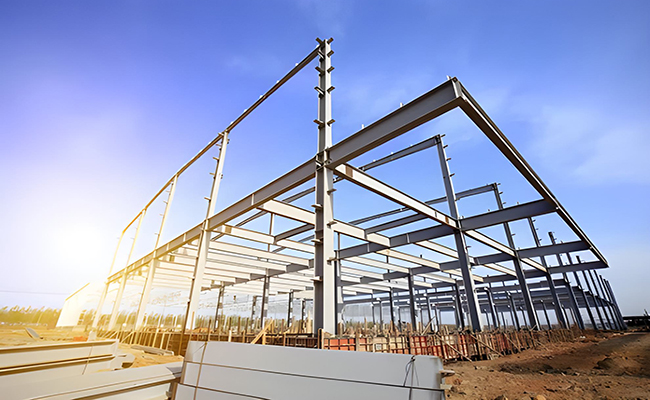
Property of steel structure:
The properties of steel structures are significant in construction. They mainly involve strength, plasticity, cold bending performance, impact toughness, welding, and durability. Steel’s chemical composition directly affects these properties.
The following are the specific effects of common elements on the property of steel structures:
1. Strength
The strength of steel is one of the most essential properties in steel structure design. It is usually measured by yield strength (σy) and tensile strength (σu). Steel structure design is based on the yield strength of steel. High yield strength can reduce the dead weight of the structure, save steel, and reduce construction costs.
As steel’s carbon content increases, the yield point and tensile strength increase, but the plasticity and impact resistance decrease.
When the carbon content exceeds 0.23%, steel’s welding performance deteriorates. Therefore, the carbon content of low-alloy structural steel used for welding generally does not exceed 0.20%. High carbon content will also reduce the steel’s resistance to atmospheric corrosion. High-carbon steel in open-air material yards is prone to rust; carbon can also increase steel’s cold brittleness and aging sensitivity.
2. Plasticity
Steel’s plasticity generally refers to its property of having significant plastic deformation without breaking after stress exceeds the yield point. The leading indicators for measuring steel’s plastic deformation capacity are elongation δ and cross-sectional shrinkage ψ.
3. Cold bending performance
The cold bending performance of steel measures its resistance to cracking when bent at room temperature to produce plastic deformation. Cold bending tests are used to test the bending deformation performance of steel under a specified bending degree.
4. Impact toughness
The impact toughness of steel refers to its ability to absorb mechanical kinetic energy during the fracture process under impact load. It is a mechanical property that measures the resistance of steel to impact load, which may cause brittle fracture due to low temperature and stress concentration. The impact toughness index of steel is generally obtained through impact tests of standard specimens.
Aluminum, titanium, vanadium, niobium. Aluminum, titanium, vanadium, niobium, and other elements are beneficial elements in steel. They are all strong deoxidizers during steelmaking and are also commonly used alloying elements. Adding these elements in appropriate amounts can improve the structure of steel, refine the grains, significantly increase its strength, and improve its toughness.
5. Welding performance
Steel’s welding performance refers to its ability to obtain a good welding joint under certain welding process conditions. Welding performance can be divided into welding performance during welding and welding performance in terms of use.
6. Durability
Many factors affect steel’s durability. The first is its poor corrosion resistance; protective measures must be taken to prevent it from corroding and rusting.
Effects of chemical elements on steel structure property
1. Carbon (C)
Carbon is the second-most important element after iron, and it directly affects steel’s strength, plasticity, toughness, and welding performance.
2. Silicon (Si)
Silicon is a deoxidizer, and its deoxidation effect is more robust than manganese. It is a beneficial element in steel. When the silicon content is low, it can improve the strength of steel but has no apparent effect on plasticity and toughness.
3. Manganese (Mn)
Manganese has a positive effect on carbon steel’s mechanical properties. It can improve steel’s hardness, strength, and wear resistance. Manganese content of less than 0.8% can significantly improve carbon steel’s yield and strength limits while maintaining its original plasticity and impact toughness.
4. Phosphorus (P)
Phosphorus can improve cutting performance and corrosion resistance so that the phosphorus content can be appropriately increased in free-cutting or weathering steel.
5. Aluminum (Al)
Aluminum has anti-oxidation and anti-corrosion properties. Aluminum, chromium, and silicon can significantly improve steel’s high-temperature non-scaling performance and corrosion resistance.
6. Titanium (Ti)
Titanium is a potent deoxidizer. It can make steel’s internal structure dense and refine the grains, reduce aging sensitivity and cold brittleness, and improve welding performance.
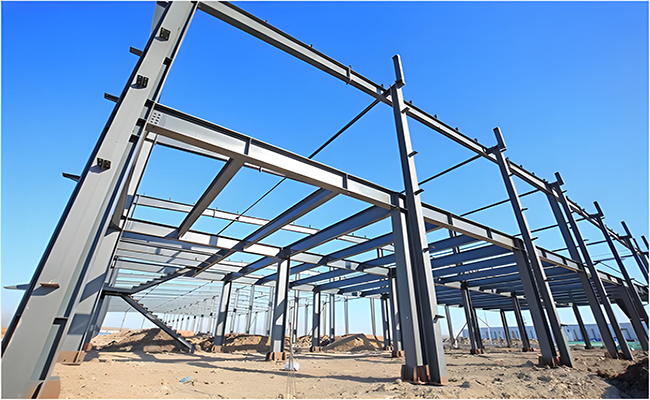
Construction methods of steel structures
Conventional steel structure construction methods
Conventional steel structure construction methods usually include two main links: factory processing and on-site installation. First, the fabrication of steel components is completed in the factory, and then the components are transported to the construction site. On site, the construction team first carries out foundation construction, and then hoists the steel columns, steel beams and wall purlins in sequence. After the installation is completed, the components are corrected, connected and fixed. The connection method usually uses bolts or welding, and finally the roof and wall installation work is carried out.
Prefabrication and modular construction of steel structures
The prefabricated modular construction method divides the construction process into two parts: prefabrication and assembly. In the factory, the production of prefabricated components, the pouring and maintenance of wall panels and floor slabs, and the assembly of building modules are all completed in the factory. After the prefabricated modules are completed, they are transported to the construction site by special transport vehicles. During on-site construction, the building modules are hoisted to the designed location, and the modules are connected into an integral structure through node connections and post-cast concrete.
Modern technology accelerates steel structure construction
With the development of modern technology, the construction process of steel structure buildings is gradually moving towards intelligence. In the design stage, digital platforms are used for integrated design. Designers can simulate building structures, optimize solutions and provide instant feedback to production links. During the construction process, robots and automated equipment are widely used, which improves the accuracy and efficiency of processes such as cutting, welding, assembly and hole making, while saving labor costs. Intelligent technology improves production efficiency and ensures construction quality.
Safety specifications for steel structure construction
Although the construction speed of steel structure is fast, safety specifications cannot be ignored. Before construction, workers must be given safety education and training, and labor protection supplies that meet the standards must be provided. Detailed construction safety, environmental protection and emergency plans are essential. When working at high altitudes, high scaffolding that meets the specifications must be set up, and operators should wear double-hook safety belts to ensure safety. Construction equipment should be inspected regularly, safety cordons should be set up in the hoisting area, and comprehensive fire protection and environmental protection measures should be equipped.
Conclusion
The future of steel structure: opportunities and trends
With the acceleration of urbanization and the continuous advancement of construction technology, the steel structure industry has ushered in unprecedented development opportunities. The future development trends of steel structure buildings are mainly reflected in intelligence, digitalization, green environmental protection, health, and the application of new technologies and new materials. In addition, steel structures will also play an increasingly important role in internationalization.
These trends are not only the mainstream direction of the future development of the construction industry, but also the key to breaking through bottlenecks and achieving sustainable development in the steel structure industry. With the advancement of science and technology and the changes in social needs, the steel structure industry will surely usher in more development opportunities and make greater contributions to the sustainable development of the construction industry.
Why steel will continue to shape the future of construction
Steel structure buildings just fit the main trends of the future development of the construction industry. With the continuous improvement of people’s requirements for healthy, intelligent, rapid construction and sustainability of buildings, the high strength, durability, construction efficiency and environmental protection characteristics of steel structures make them an ideal choice for future buildings. While meeting environmental standards and providing fast and efficient construction, steel structures can ensure the safety and comfort of buildings and are the core materials that promote the development of future buildings.
Final thoughts on the diversity and strength of steel structures
Steel structures have many advantages, but they are still not widely used in residential buildings. With the continuous development of new building formats, the demand for prefabricated steel structures is growing, especially in high-rise buildings. Although the durability and safety of steel-structured high-rise residential buildings are still subject to certain doubts, with the continuous innovation of technology and the development of engineering practice, prefabricated steel structures are expected to solve these problems.
At this stage, the theory of steel-structured housing has gradually been scientifically established, and many construction technologies, structural innovations and optimization measures are still being explored. With interdisciplinary innovation and coordination, steel-structured housing will become one of the mainstream trends in the construction industry in the future, further promoting the progress of the construction industry.












